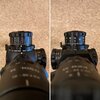Computers, tools, calculators are all nice. But I'm the kind of guy that needs to know where the numbers come from. Some competitions allow tools others don't. So I like to be ready to do it on my own
At the risk of sounding curt, it's simple fallacy to believe if you don't have a ballistic calculator that you'll do the math "longhand." You won't, and frankly DAMNED SURE can't do so expediently in the field or during a match, even if you do have the skills and understanding the physics and differential calculus to do so. Honestly, I'd bet heavily against more than one or two other folks commenting in this thread having ever calculating trajectory longhand, or even in software like matlab or Excel.
Plainly, guys aren't talking about calculating trajectory longhand, they're talking about using a crude measurement tool which is only useful for delivering approximate fire on large targets at what are still short ranges.
Here's the rub: you need two numbers to deliver shots on target downrange - you need the vertical "elevation" correction corresponding to the range you're shooting (compounded by the wind influence on vertical displacement) and you need the horizontal "windage" correction required to compensate for the wind in which you're shooting (compounded by spin drift over distance you're shooting). But you'll never do that "math" which actually yields those numbers. It's an absolute waste of time for any shooter to independently develop the math skills and then calculate drop based on a differential velocity model, let alone a differential drag model (AB CDM's, Hornady 4DoF profiles). When we don't have access to ballistic calculators (and many of us have been shooting LR since before we had calculators), we still don't calculate trajectory longhand, we either 1) look up trajectories based on ballistic tables or 2) shoot multiple ranges in the field, walking shots onto target and recording corresponding corrections to establish our own DOPE books - Data On Previous Engagements. I spent countless hours in the back of the Speer 13th manual in the late 1990's and early 2000's reading ballistic tables, plotting that onto graph paper to interpolate smaller increments, and extrapolating longer distances as a starting point for going to the range and developing my own longer range data tables (DOPE books). Nobody is doing any "math" to solve for trajectory.
So all of the "math" guys talk about in this discussion really is just novelty stuff, like gross range estimation, after which they still have to go back to a DOPE book or other data table, or ballistic calculator to determine the two numbers we're actually using. It's cute to talk about using known or estimated target sizes to estimate distances, and if you're shooting huge targets at short distances, sure, it works well enough - but it's not long range shooting, and it's not pertinent for PRS competition. Sure, if you just need to put a bullet anywhere on a man-sized target at 400-600yards it's useful, but for actual long range shooting and trying to hold onto reasonably sized targets (not billboards), mil-ranging just isn't useful. Here's an example: Picking a reasonably sized target I shoot relatively often, let's say I KNOW a target is exactly 12" and I read 0.3mils - that's 1112yrds... But wait... maybe it was 0.35mils (meaning my error lining up the target in the reticle hashes was literally the width of the lines in my scope), 12" subtending 0.35mils is only 953yrds, so 159yrds worth of ranging error, which for my 300win mag load, that's 8.9 FEET of error, all because I couldn't discern whether a 12" target at nearly 1000yrds was spreading between the centers of two lines, or the outside edges... Missing a target by almost 9 times its own size... That's not really math I would consider pertinent for any kind of Long Range shooting I have ever done...
VERY SPECIFICALLY TO PRS COMPETITION: You'll be provided ranges at PRS matches and you'll be allowed to use a laser rangefinder if you ever think the ranges provided in the match book are incorrect. Nobody on any squad at any match I've ever shot would want to stand around and waste time waiting for a shooter to mil-range targets, and most matches don't provide sizes for all of targets, many don't provide sizes for ANY of the targets. There USED TO BE matches occasionally which would include a "blind stage" or a "milling stage" where guys had to either range with the LRF and determine trajectory on the clock, usually 5min stages instead of 90/105/120 sec, or where guys had to mil-targets to determine the range, but again, these were huge targets, and guys used their phones to read the mils in the scope, calculate target inches / mils read * 27.8, then put that number into their ballistic engine. At WORST, throw a trajectory data table on your wrist coach, and that ONE formula will give you all of the info you'll ever need - or rather NEVER need, because we don't do that at PRS matches. Know 1 formula in case you get stuck with a mil-ranging stage - which I haven't heard of happening in at least 3years at a regional series match, and I have NEVER heard of one at a pro series match in the 7yrs I've been shooting PRS.
Maybe I should have been more clear about these REASONS this math is a waste of time in my first post instead of simply pointing out that it's a waste of time... It's not worthwhile to do the worthwhile math longhand, and the math being described above for mil-ranging is not worthwhile math for long range shooting, especially not for PRS shooting.





